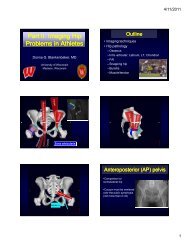Ankle and Foot 47 - Department of Radiology - University of ...
Ankle and Foot 47 - Department of Radiology - University of ...
Ankle and Foot 47 - Department of Radiology - University of ...
You also want an ePaper? Increase the reach of your titles
YUMPU automatically turns print PDFs into web optimized ePapers that Google loves.
<strong>47</strong> <strong>Ankle</strong> <strong>and</strong> <strong>Foot</strong> 2237 <strong>47</strong><br />
Figure <strong>47</strong>-39. The os calcaneus secondarius (OCS)<br />
is an occasionally seen normal variant that resides<br />
between the anterior process <strong>of</strong> the calcaneus (APC)<br />
<strong>and</strong> the lateral pole <strong>of</strong> the navicular (N).<br />
Radiographs<br />
Figure <strong>47</strong>-40.<br />
Flow chart for imaging ankle <strong>and</strong> foot (see text).<br />
CT<br />
MRI US NM<br />
Assess cortex<br />
• Fractures<br />
-Calcaneus<br />
-Distal tibia<br />
-Lateral<br />
process <strong>of</strong> talus<br />
• Arthritis<br />
• Fusions<br />
• Coalitions<br />
-Osseous<br />
-Nonosseous<br />
Everything else<br />
• Tendons<br />
-Tears<br />
-Tenosynovitis<br />
• Masses<br />
-S<strong>of</strong>t tissue<br />
-Osseous<br />
• Bone pathology<br />
-Occult fracture<br />
-Osteochondral<br />
lesions<br />
-Infection<br />
• Tendons<br />
-Achilles<br />
• Toes<br />
-Morton’s<br />
-Plantar plate<br />
• Masses<br />
-Vascularity<br />
-Cyst vs solid<br />
• Foreign bodies<br />
-Wood<br />
• Screening<br />
-Sesamoid<br />
• Charcot<br />
Figure <strong>47</strong>-40 is a flow chart outlining which modalities we<br />
use to image various pathologic processes.<br />
CT is used when we specifically need to assess<br />
bone cortex. The ability to reformat CT data into twodimensional<br />
cross-sectional images in any plane desired<br />
makes it the ideal modality to assess the intra-articular<br />
extent <strong>of</strong> fractures, especially complex fractures involving<br />
the distal tibia or calcaneus. This is particularly helpful to<br />
orthopedic surgeons as part <strong>of</strong> their presurgical planning.<br />
CT data can also be volume rendered into threedimensional<br />
projections to show the alignment <strong>of</strong> comminuted<br />
fractures. CT is also useful for showing fractures<br />
that are difficult to see radiographically, such as the lateral<br />
process <strong>of</strong> the talus or the anterior process <strong>of</strong> the calcaneus.<br />
CT can be used to show arthritic narrowing <strong>of</strong> joints that<br />
are difficult to visualize radiographically, such as the subtalar<br />
joint. In patients who have undergone a surgical<br />
arthrodesis in an attempt to fuse a painful arthritic joint<br />
who remain symptomatic, CT can show the degree <strong>of</strong> bone<br />
fusion at the cortical level. CT is also the best modality to<br />
show the abnormal bone cortex in cases <strong>of</strong> tarsal coalition,<br />
both solid osseous <strong>and</strong> nonosseous coalitions.<br />
MRI is essentially used for everything else. MRI is the<br />
best way to evaluate all <strong>of</strong> the ankle tendons at once for<br />
tears or tenosynovitis. It is the best way to evaluate masses<br />
arising from either the s<strong>of</strong>t tissues or bones <strong>of</strong> the extremities.<br />
MRI is extremely sensitive for the detection <strong>of</strong> bone<br />
marrow <strong>and</strong> s<strong>of</strong>t tissue edema/inflammation, <strong>and</strong> as such<br />
is it useful for the detection <strong>of</strong> conditions that may be<br />
radiographically occult, including stress fractures, osteochondral<br />
lesions, <strong>and</strong> infection.<br />
Ultrasonography (US) can be used to perform a<br />
focused examination <strong>of</strong> the s<strong>of</strong>t tissues <strong>of</strong> the ankle or foot.<br />
Unlike MRI, which images all <strong>of</strong> the ankle bones <strong>and</strong><br />
tendons at once, US is used when we wish to examine one<br />
specific tendon. US is particularly useful when we wish to<br />
examine a torn Achilles tendon in a dynamic fashion to<br />
see how much the tendinous gap opens between plantar<br />
Ch0<strong>47</strong>-A05375.indd 2237<br />
9/9/2008 5:34:13 PM
















